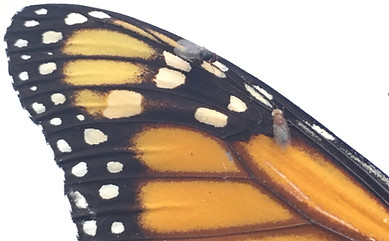
Marianthi (Marianna) Karageorgi
Μαριάνθη (Μαριάννα) Καραγεώργη
Mechanisms of evolution of novel adaptive behaviors: multistep evolution of sensory ecology in a Drosophila agricultural pest. During my PhD at the Marseille Developmental Biology Institute, I studied how organisms evolve new behaviors to adapt to novel niches. By applying CRISPR and neurogenetic tools in Drosophila suzukii, we discovered that this agricultural pest evolved a preference for fresh fruit through stepwise integration of sensory systems (Karageorgi et al., 2017). This work provided crucial insights into how pest behaviors evolve and established a framework for studying behavioral evolution at the genetic level.
Mechanisms of evolution of toxin resistance: retracing an adaptive walk to toxin resistance in the monarch butterfly. In my postdoc at UC Berkeley, I led an international collaboration to study a textbook example in ecology and evolution - how the monarch butterfly evolved resistance to toxins of its host plants (Karageorgi et al., 2019). The monarch butterfly and other specialist insects have convergently evolved resistance to cardiac glycosides (CGs), toxins of their host plants that inhibit the sodium pump (ATPα). By leveraging convergence, we first discovered a constrained adaptive walk involving stepwise substitutions at three amino acid sites in the ATPα of specialist insects of CG-producing plants. Focusing on the monarch butterfly lineage, we then used CRISPR and introduced these three mutations in the order they were inferred to evolve into D. melanogaster. We found that these mutations confer resistance by preventing binding of CGs – a mechanism known as target site insensitivity - but they also exacted fitness costs. Importantly, we found that the earliest mutation in the adaptive walk partially compensated for these fitness costs, revealing how tradeoffs constrained the path to resistance. These results were groundbreaking because we identified the key mutations that allow the monarch butterflies feed on their toxic host plants and showed that CRISPR can be used to retrace an adaptive walk.
Mechanisms of long-term maintenance of insecticide resistance in Drosophila populations and consequences for other seasonal adaptive processes. At Stanford University, I received the K99/R00 Pathway to Independence Award and led a collaboration to study how resistance to organophosphates, the most widely used insecticides, persists in natural populations of D. melanogaster and how it affects other seasonal adaptive processes. By combining experimental evolution in field population cages under seasonally fluctuating presence and absence of organophosphates with large-scale phenotypic and genomic time series analyses, lab measurements, and mathematical modeling, we studied the evolution of large-effect alleles at the Ace locus in D. melanogaster conferring resistance to organophosphates. We discovered that these resistant alleles are maintained through dominance shift -- they switch from dominant and beneficial in the presence of insecticides to recessive and harmful in their absence -- providing the first compelling evidence for a long-proposed theoretical model of maintaining genetic variation in seasonally fluctuating environments (Karageorgi et al., 2024). In investigating how organophosphate exposure affects other seasonal adaptive processes, we found that while fluctuating insecticide selection generated fluctuating chromosome-scale genomic perturbations of allele frequencies in the field population cages, the population dynamics and other seasonal phenotypes remained unaffected (Karageorgi et al., in preparation). This suggests that seasonal adaptive processes can persist in natural populations despite strong human anthropogenic pressures.